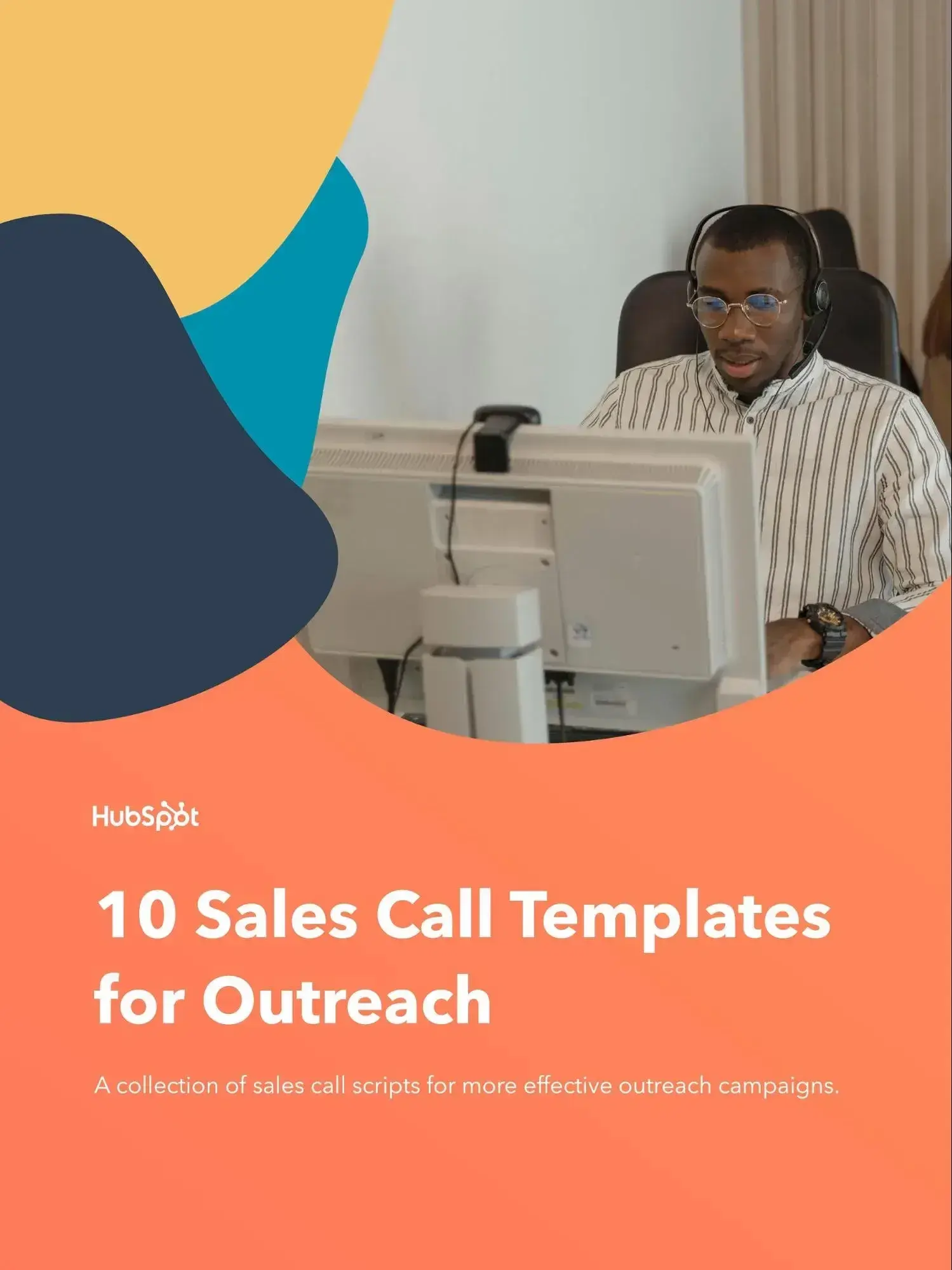
I still remember the first time I froze on a sales call.
I had no script, no structure. I just had a vague idea of what I was selling and a whole lot of nerves. The executive on the other end waited in silence after my clumsy pitch, and all I could think was, “I’m never letting this happen again.”
Since then, I’ve built and tested hundreds of sales scripts across industries, deal sizes, and stages of the funnel. From early-stage startups to enterprise clients, from cold calls to strategic follow-ups — I’ve seen what works and what falls flat. And here’s what I’ve learned: The best scripts don’t sound like scripts. They sound like confident, relevant conversations.
You don’t need robotic lines. You need rhythm. Structure. A compass.
In this guide, I’m going to walk you through the process I’ve refined over the last decade, covering exactly how I build sales scripts that feel natural, convert consistently, and scale trust with decision-makers.
Whether you’re a new rep still finding your voice or a seasoned seller looking to tighten your messaging, you’ll find examples, templates, and battle-tested tips to help you craft scripts that actually work, without sacrificing authenticity.
Let’s dive in.
Table of Contents
What is a sales script?
Let me start with this: I don’t use sales scripts to sound robotic. I use them so I don’t sound like one.
When I talk about sales scripts, I’m not referring to word-for-word monologues you recite like an actor. I’m talking about structured, intentional frameworks designed to keep your message clear, your tone human, and your outcomes consistent. A great script is a compass, not a cage.
In my experience, the best salespeople I’ve coached or worked with use scripts not to control the conversation, but to guide it. We’re not trying to manipulate buyers — we’re helping them make decisions. And when you’re in the middle of a high-stakes call, having a well-crafted script in your back pocket can be the difference between staying grounded and going blank.
At its core, a sales script is a repeatable set of talking points, questions, insights, and transitional lines that help you move a conversation forward — from opener to next step — with confidence and flow. It keeps your message aligned with the prospect’s needs and your tone aligned with the context.
And here’s why that matters: According to Gong’s analysis of thousands of objections during sales calls, top-performing reps respond to objections with clarifying questions 54.3% of the time, compared to just 31% for average reps. Consistency builds trust, and trust closes deals.
How Sales Scripts Help Sales Reps
Let me give you a real-world comparison.
When I work with startups or consultants building outbound playbooks, script architecture is one of the first things I teach. Not just what to say, but why you’re saying it. I tell them to consider who they’re selling to and how to adapt the script in real time. Because when you’re cold-calling a COO or presenting to a skeptical CTO, winging it doesn’t cut it.
I once helped a B2B founder rework their outbound script after hearing one of their reps get shut down three calls in a row. The problem? They were leading with features. No context, no relevance. Once we built a pain-first, benefit-anchored script with real industry triggers, their reply rate jumped by 4.6% in two weeks, and meetings doubled the month after.
Here’s the truth: A script won’t save a bad product or force a decision that isn’t ready. But it will help you sound more confident, handle objections with poise, and move from transactional pitches to transformational conversations.
If you’re still thinking, “But I don’t want to sound scripted,” good. You shouldn’t. Because the goal isn’t to follow a script — it’s to internalize it so deeply that it becomes second nature.
Just like musicians learn scales so they can improvise, sales pros learn scripts so they can connect.
How to Write a Sales Script
Let’s be clear: I don’t write scripts to sound polished. I write them to stay sharp. To guide the conversation without controlling it. To make sure my message is clear under pressure — and to help new reps skip the awkward learning curve I had to stumble through.
Below is my actual process. This is what I’ve used to train SDRs, founders, consultants, and closers across multiple industries — from SaaS to staffing, supplements to AI tools. I’m not guessing. I’m giving you the blueprint I’ve battle-tested through thousands of cold calls, LinkedIn DMs, and email threads.
Step 1: Start with your ICP’s “Oh, That’s Me” moment.
Before I write a single line of any sales script, I pause and put myself in my buyer’s shoes. Not just in a general “Hey, they’re a CMO at a SaaS company” kind of way, but in a visceral, time-sensitive, emotionally charged way. I ask myself, “What’s happening in their world right now that would make them say, ‘Oh, that’s me’ the second they read or hear this message?”
I’m not trying to impress them with features. I’m trying to interrupt a specific moment in their mental feed. When I built a script for an AI staffing platform targeting overwhelmed tech leaders, I didn’t open with “We help tech teams scale talent.” That’s safe. That’s vague.
Instead, I said: “You know that moment when your backlog just doubled and your lead engineer walked out the door? That’s usually when we get the call.” It worked — not because it was clever, but because it was precise.
The key is timing, not polish. According to a 2023 LinkedIn study, 76% of decision-makers say they’re more likely to engage with outreach that reflects a deep understanding of their day-to-day challenges. So, every time I script, I obsess over that moment. Not the persona. The pain.
Step 2: Anchor to one problem (not a list of features).
One of the biggest mistakes I see — and yes, I’ve made it myself — is trying to cram too many value props into a single message. I used to think I was adding value. But I was just adding noise.
If you give a buyer five reasons to care, they won’t remember any. But if you mention one burning problem they’re actively dealing with, they’ll pay attention. Especially if that problem has a clear, measurable outcome attached.
When I worked with a B2B SaaS company on their discovery call script, we stripped away everything that wasn’t essential. No more bullet-point benefits. No more “We do this, this, and this.” We landed on one pain point, crystal clear: “We help ops teams cut manual workflows by 40% — without adding dev time.”
That was it. And the result? More booked calls and less confusion.
I always tie the pain to a business outcome, not just a task. Because the higher you go in the org chart, the more that matters. The CFO doesn’t care that a dashboard loads faster. They care that faster reporting means faster decisions — and that impacts revenue.
Step 3: Frame your solution like a category, not a commodity.
One shift that’s changed the way I sell — especially when I’m introducing a product for the first time — is learning to speak in categories, not commodities.
When I tell a prospect, “We offer AI voice agents for customer support,” they think: “Oh, another chatbot.” But when I say, “Imagine your best rep — but one that never sleeps and handles 80% of calls automatically,” they lean in. I’m no longer asking them to buy a product. I’m inviting them to picture a new way of working.
This technique isn’t just fluffy storytelling. There’s science behind it. Gong found that top-performing reps are 55% more likely to use visual analogies in their pitch. Why? Because metaphors build memory. And memory builds momentum.
If you’re struggling to make your product feel “new,” start here. Reframe it not by what it is, but by what it replaces, simplifies, or amplifies.
Step 4: Use strategic questions to pull, not push.
The best scripts don’t tell. They guide. And the most powerful way I’ve found to guide a conversation is through well-crafted, tension-building questions.
I don’t ask, “Are you interested in AI automation?” That’s binary. That’s easy to shut down. Instead, I ask, “What happens when your team gets slammed with DMs while everyone’s offline?” That creates friction, and friction is fuel for curiosity.
Great sales scripts lead the buyer to their own realization. Because here’s the truth: When a prospect says the problem out loud, it becomes real. And once it’s real, they need a way to solve it.
I treat every question like a breadcrumb. Each one nudges the prospect toward a gap they didn’t know was costing them time, money, or sleep. The right question at the right time? It doesn’t just move the deal forward. It repositions you from vendor to advisor.
Step 5: Script the first 20 seconds, not the whole call.
I’ll let you in on something that took me years to learn: The goal of a script isn’t to control the call. It’s to earn the right to keep it going.
That’s why I only script the first 20 seconds — the intro, the hook, and the reason I’m reaching out. After that, it’s all improv. Intentional improv, yes. But improv nonetheless.
Here’s one I used recently that got a 44% reply rate on cold calls:
“Hey [Name], I’ll be super quick — this is Diego. I help SaaS founders automate outbound without hiring SDRs. Built something that’s been getting wild results — mind if I give you the 30-second version?”
It’s short. It’s confident. And most importantly, it asks permission. That micro-yes? It shifts the dynamic. I’m not pushing in — I’m being invited in. And when that happens, the odds of a real conversation shoot way up.
Step 6: Build objection responses into the flow.
Here’s where most reps go wrong: They wait for objections and then scramble. I prefer to beat objections to the punch.
If I know a founder is going to say, “We already have a chatbot,” I address it before they do:
“You might already have something that kinda does this, but most of our clients switch when their volume spikes and things start breaking.”
By acknowledging the objection early, I control the frame. I show empathy without losing momentum. It’s not defensive — it’s proactive. And it isn’t just good selling, it’s neuroscience. When people feel heard, their resistance drops. So instead of arguing, I validate. And then I reframe.
This technique has saved countless deals for me, especially in competitive markets where status quo bias is strong. If you’re not addressing objections upfront, you’re leaving too much room for doubt to fester.
Step 7: End with a micro-commitment, not a close.
Here’s a controversial take: I don’t try to close the deal on the first call. I close out of curiosity.
When the call’s winding down, I might say, “This might not be for you — but if you’re even 10% curious, I can send you a 90-second demo. Worst case, you steal a few ideas.” That’s it. No pressure. No “When’s a good time for a 30-minute call next week?”
This approach works because it’s low-friction. It gives the buyer an easy out while still moving the conversation forward. And the data backs it up. According to Outreach.io, calls that end with low-pressure CTAs like “open to a quick look?” have a 31% higher reply rate than hard closes. But honestly? I don’t need data to believe it — I’ve lived it.
At the end of the day, I don’t sell through pressure. I sell through pull. I want my prospects leaning in, not backing away. And a well-placed micro-commitment is often all it takes to spark that next step.
Sales Call Script Sample
Let’s get something straight — I don’t believe in fantasy scripts. You won’t find any robotic lines or recycled phrases here. What you’re about to read is the real script structure I’ve used to book meetings with C-level executives, busy founders, and no-nonsense decision-makers in SaaS, AI, real estate, and beyond.
I’ve tested this on thousands of calls across global markets and industries — and I’ve coached SDRs, founders, and enterprise teams to use it, tweak it, and own it. It works because it’s not rigid. It works because it respects the person on the other end. And, it works because it balances tension and trust in the first 30 seconds, which is where most reps lose the game.
This script isn’t magic. But it’s built to do one thing exceptionally well: start a real conversation.
Cold Call Sales Script (Built for Humans, Not Robots)
Step 1: Pattern Interrupt & Permission
“Hey [First Name] — it’s Diego. I know you weren’t expecting this, so I’ll be brief. Do you have 30 seconds to see if this is even worth a chat?”
Why this works:
I don’t pretend I’m not interrupting them — I lean into it. This isn’t about tricking someone into a conversation. It’s about being direct, respectful, and composed. When I lead with permission, I shift the power dynamic. I’m not pushing my way into their day — I’m offering them the option to opt in. That micro-yes? It unlocks the door.
I’ve found that even C-level execs, the busiest people in the building, appreciate this approach. It’s disarming. It signals that I understand their time is valuable — and that I’ll earn their attention, not hijack it.
Step 2: Role-Specific Problem Hook
“I work with [ICP type, e.g., B2B founders] who are scaling but stuck spending 10+ hours a week on manual outreach. Usually, by the time we talk, they’re either about to hire a junior SDR — or regretting that they already did.”
Why this works:
Notice what I didn’t do here: I didn’t say “We’re a platform that does XYZ.” I didn’t talk about features. I went straight to their lived experience — something they feel in their body at 8 pm when they’re still typing follow-up emails.
I always aim to hold up a mirror. I want the person on the other end to say, “That’s exactly where I am right now.” Because once someone feels seen, they’re far more likely to lean in. And the specificity of this hook isn’t accidental — it comes from actually living these calls, not theorizing them from a desk.
Step 3: Social Proof Tease (Optional but Powerful)
“For context, I just helped a SaaS founder in Austin go from zero to 14 meetings/month in 30 days — no SDR, no cold emails, just one AI agent doing the heavy lifting.”
Why this works:
I don’t launch into a 3-minute case study here. I don’t name-drop logos. I tease just enough social proof to create credibility, without triggering sales resistance. I call this “the credibility breadcrumb.”
It’s subtle, but effective. It says, “You’re not alone — and this isn’t my first rodeo.” And that creates psychological safety. Because if I’ve done it for someone like them, there’s a chance I can do it again. And that opens the door to possibility, which is what keeps a call alive.
Step 4: Insight-Based Question
“Quick question — how are you currently handling outbound right now? Is it founder-led, or do you have reps doing cold outreach?”
Why this works:
This is the turning point — from pitch to dialogue. I’m not fishing for surface-level info. I’m inviting them to reflect, to tell me where they are in their journey. And when they answer, I’m not just listening for what they say. I’m listening to how they say it. The tone. The energy. The frustration behind the facts.
A great question is one that makes the buyer pause. It reframes the moment. And it lets them feel, not just respond. When I hear a gap in their process, I don’t jump in with solutions. I sit with it. I give it space. Because in sales, silence is often where trust is built.
Step 5: Tension + Micro Close
“Got it. Based on that, there might be a fit. I’m not sure yet. But if you’re even 10% curious, I can send over a 90-second video showing how it works — worst case, you steal the idea. Would that be fair?”
Why this works:
Here’s where I separate myself from the pushy reps. I’m not asking for a full demo. I’m not pressuring for a calendar slot. I’m offering curiosity — and that’s a much easier yes.
This phrasing matters: “I’m not sure yet.” That one sentence signals honesty. I’m not assuming I can help. I’m exploring if I can. That nuance builds respect. And the “steal the idea” line? That’s pure pattern interrupt — and it works wonders because it lowers the stakes.
Low-friction CTAs like this can significantly boost reply rates.
Real-World Example: Voice AI Sales Call
Let’s break it down even further. Say I’m selling a Voice AI Agent that follows up with real estate leads in under 60 seconds. Here’s exactly how I’d run this cold call using the structure above:
“Hey Mark, this is Diego. I’ll keep this quick — do you have 30 seconds for context?
“I work with real estate teams who lose dozens of leads every week because no one has time to call them fast. One client told me, ‘If we don’t follow up in five minutes, we lose them to Zillow or Redfin.’
“We set up a Voice AI agent that calls every new lead in under 60 seconds. It books meetings, answers questions, and sounds human. They went from chasing leads to choosing who they work with.
“How are you handling new inbound leads right now? Is it manual or automated?”
[They answer.]
“Appreciate you sharing that. If you’re open to it, I’ll send a short clip — 90 seconds tops — showing how it works in real time. If it sparks ideas, we talk. If not, no worries. Sound fair?”
No tricks. No push. Just relevance, timing, and tone. That’s what turns a cold call into a warm opportunity.
Final Thought
A sales script should never feel like a script. It should feel like a rhythm.
I write scripts to open space. Space for relevance, for reflection, for trust. That’s what the best scripts do. They don’t shout. They signal.
And the reps who win? They don’t sound perfect. They sound real. They sound like someone worth talking to. Someone who gets it. So take this script. Make it your own. Tweak it. Test it. Say it out loud and stumble over the words — that’s how you find your flow.
Because at the end of the day, you’re not just selling a solution. You’re selling the experience of being understood.
Sales Script Templates
Download Sales Call Scripts for Free
Ready to begin creating your own script? Use these templates as a starting point.
1. Outreach Call Script
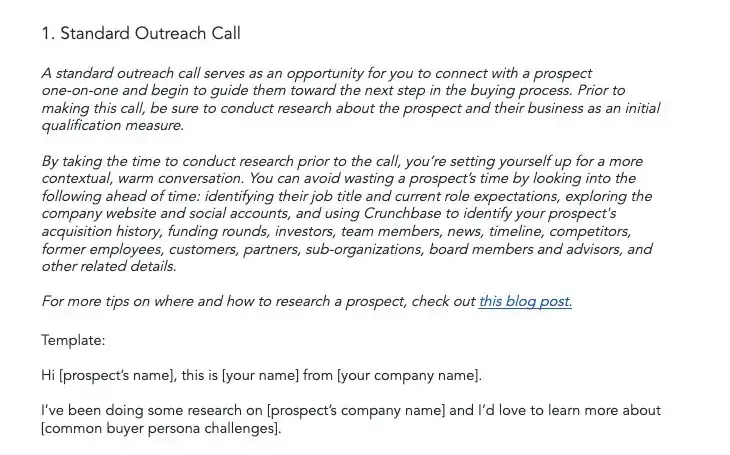
Download This Sales Call Script for Free
The outreach call is the deal-starter. It’s your chance to begin on the right foot with a prospect.
This sales call script from HubSpot allows you to showcase that you’ve done your research, and you’ll begin warming the lead without coming across as overly pushy. It comes with two options, depending on whether the prospect wants to continue the conversation or presents an objection.
2. Gatekeeper Call Script
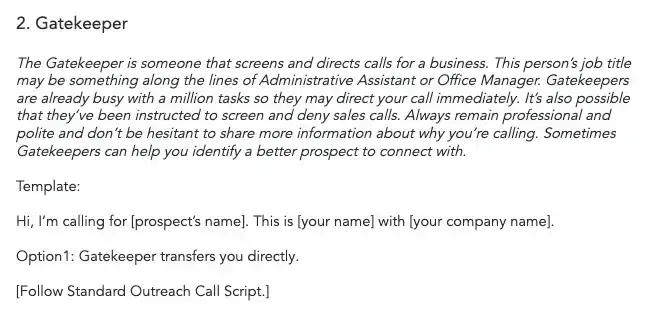
Download This Sales Call Script for Free
Gatekeepers can be anyone, from office administrators to entry-level employees who won’t be using the tool or making the final decision.
Use this sales call script to get to the right contact. That way, you don’t waste time warming a lead who’s not even close to the decision-makers. The script allows you to stay succinct and professional and provides different script options depending on the outcome.
3. Discovery Sales Call Script
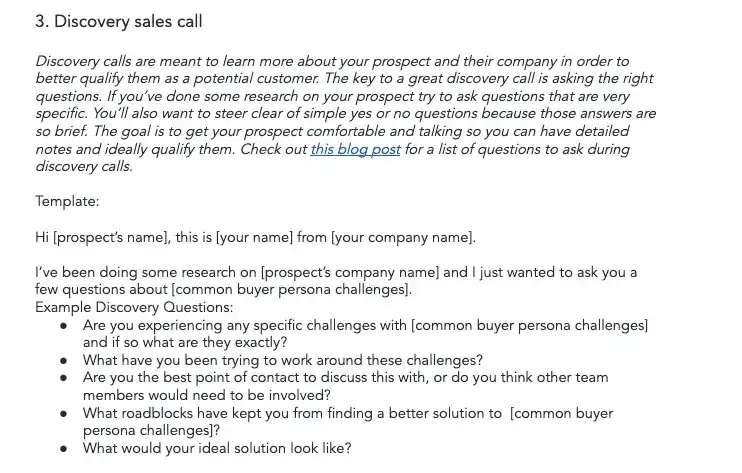
Download This Sales Call Script for Free
The discovery call is the crowning glory of a new deal. It’s your chance to uncover your prospect’s needs at length — and to further qualify them. It’s a good time to identify whether they’re a good-fit prospect and therefore worth pursuing.
This script is flexible enough for different industries and personas. You can get as granular about pain points as you’d like — or, if the prospect still seems reluctant, ask high-level questions that lead them slowly toward articulating their needs. Like all scripts, you’ll have different options depending on your prospect’s response.
4. Following Up Call Script
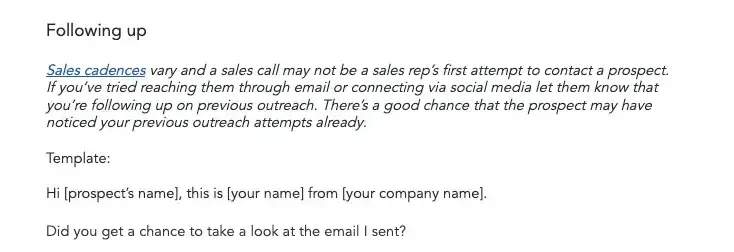
Download This Sales Call Script for Free
Following up is a must to stay top-of-mind and ensure you’re doing everything possible to lead prospects toward a pitch meeting.
This script is short, sweet, and easy to customize. We also love that it includes instructions to ask why the prospect may not be interested. Every call is an opportunity to further qualify prospects and refine buyer personas.
These are not the only call scripts you should incorporate into your sales process. Download the full kit here for free and get scripts for making 1:1 connections, sharing a product promotion, and more.
Sales Script Examples
I’ve written thousands of scripts in my career, and thrown out almost as many.
I’ve tested scripts that fell flat in the first 10 seconds … and others that cracked open C-suite deals worth six figures. Over time, I realized: the best scripts aren’t clever. They’re clear. They don’t manipulate — they resonate. And they’re built not to sell on the spot, but to earn curiosity, build trust, and guide a conversation that actually goes somewhere.
So in this post, I’m breaking down the real frameworks I use today. Not theory. Not guesswork. These are the exact scripts and mental models I’ve taught teams across startups and Fortune 500s — grounded in psychology, refined in thousands of calls, and designed to work across cold calls, DMs, emails, and even breakup messages.
Let’s get into it.
1. Sales Call Script Templates
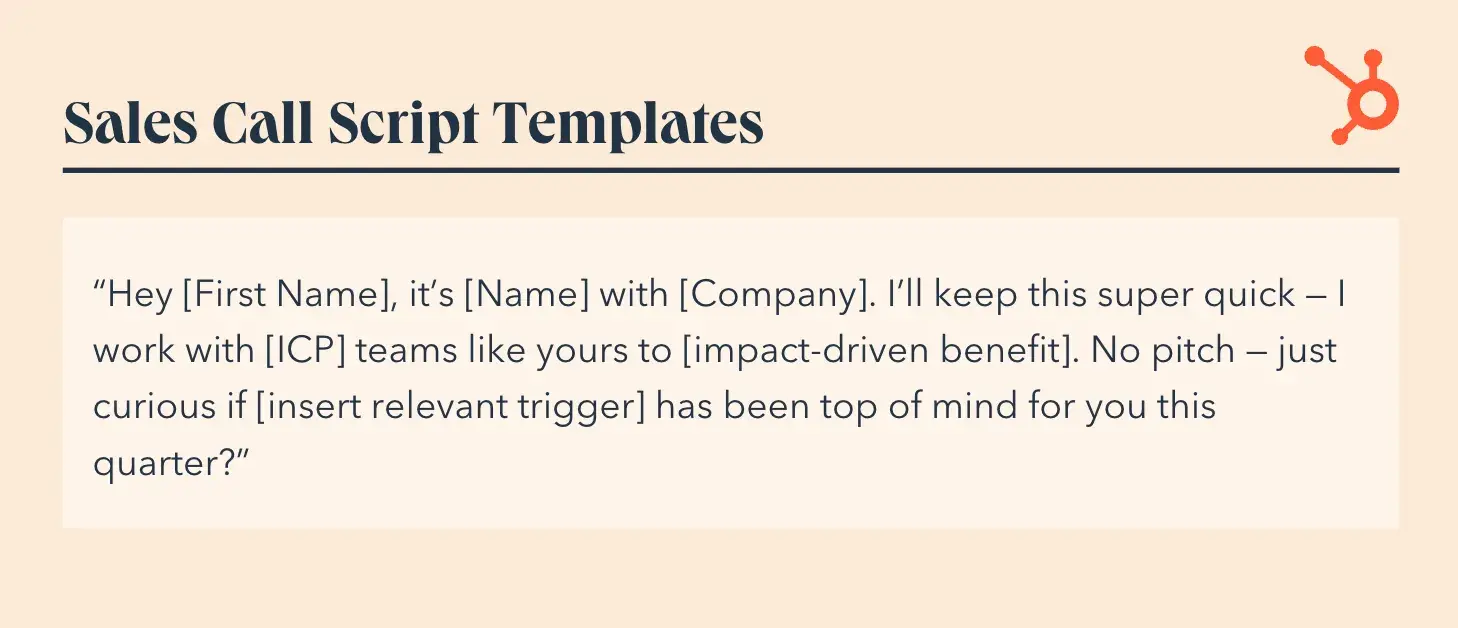
Cold calling, for me, has always been about rhythm, not pressure. When I pick up the phone, I’m not hunting for a “yes”… I’m looking for permission. That first 20 seconds? It sets the tone for everything. If I come in hot with a pitch, I sound like a salesperson. But if I show respect, relevance, and restraint? I sound like a peer.
Here’s a version I’ve used that opens more doors than most:
“Hey [First Name], it’s Diego with [Company]. I’ll keep this super quick — I work with [ICP] teams like yours to [impact-driven benefit]. No pitch — just curious if [insert relevant trigger] has been top of mind for you this quarter?”
And if they say, “Yeah, what’s this about?”, I follow up with:
“Some teams I’ve worked with in your space were hitting roadblocks around [pain point], and what helped them was [solution preview]. Would it make sense to compare notes on how you’re tackling it?”
No pressure. No scripts that sound like they were spat out by ChatGPT and never edited. Just clarity, confidence, and curiosity — the three C’s I bring to every first call.
2. Sales Script for Working a Gatekeeper
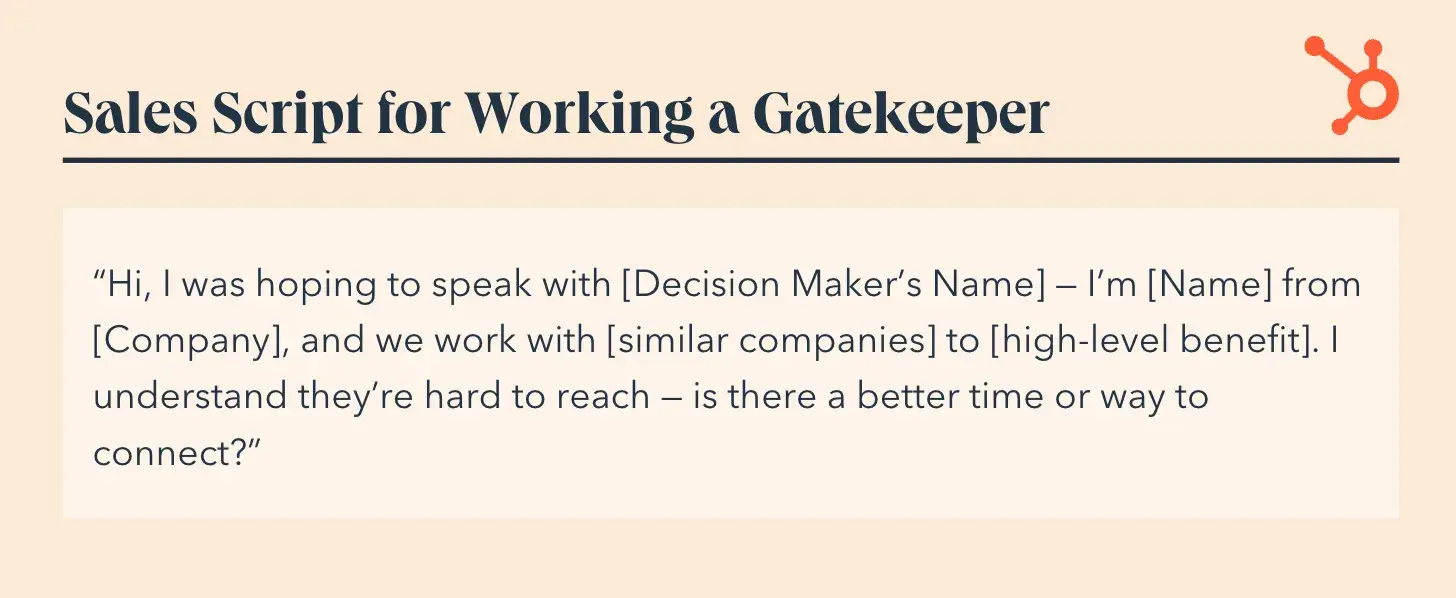
A lot of reps treat gatekeepers like obstacles. I don’t. I treat them like allies.
I’ve gotten through to CFOs, CMOs, and even heads of security in oil and gas — not because I forced my way in, but because I showed respect to the person who picked up. I acknowledged their role and asked for guidance, not access.
Here’s how I usually start:
“Hi, I was hoping to speak with [Decision Maker’s Name] — I’m Diego from [Company], and we work with [similar companies] to [high-level benefit]. I understand they’re hard to reach — is there a better time or way to connect?”
And if they push back, I don’t resist. I pivot:
“Totally understand. If it helps, I just wanted to share something time-relevant — can I send a short note for them to review first?”
When you make the gatekeeper’s job easier, not harder, you’re far more likely to get the transfer.
3. Sales Script for Referencing a Mutual Connection
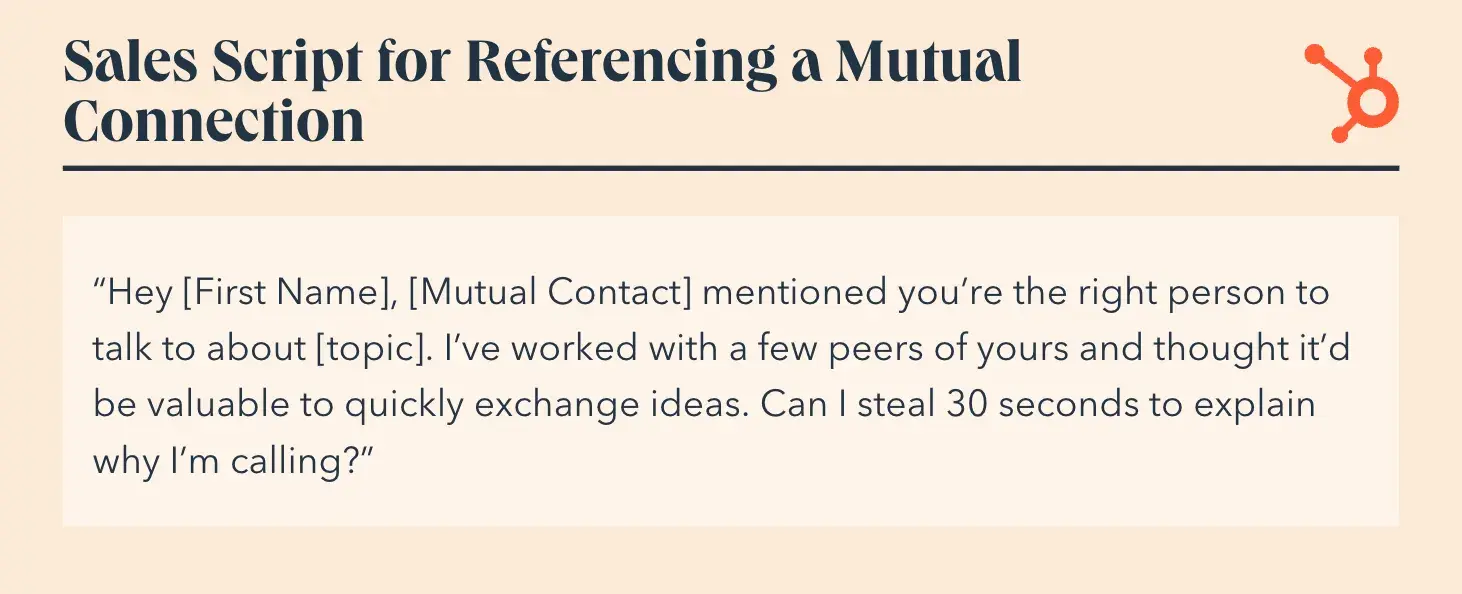
Nothing builds trust faster than relevance. And mutual connections? They’re a shortcut to credibility — but only if they’re real.
When I reference someone, I don’t name-drop. I anchor it to context.
“Hey [First Name], [Mutual Contact] mentioned you’re the right person to talk to about [topic]. I’ve worked with a few peers of yours and thought it’d be valuable to quickly exchange ideas. Can I steal 30 seconds to explain why I’m calling?”
It works because it’s low-pressure, specific, and grounded in a shared network. If they give me the green light, I don’t pitch. I pivot into discovery and let the conversation evolve naturally.
4. Sales Script for Email
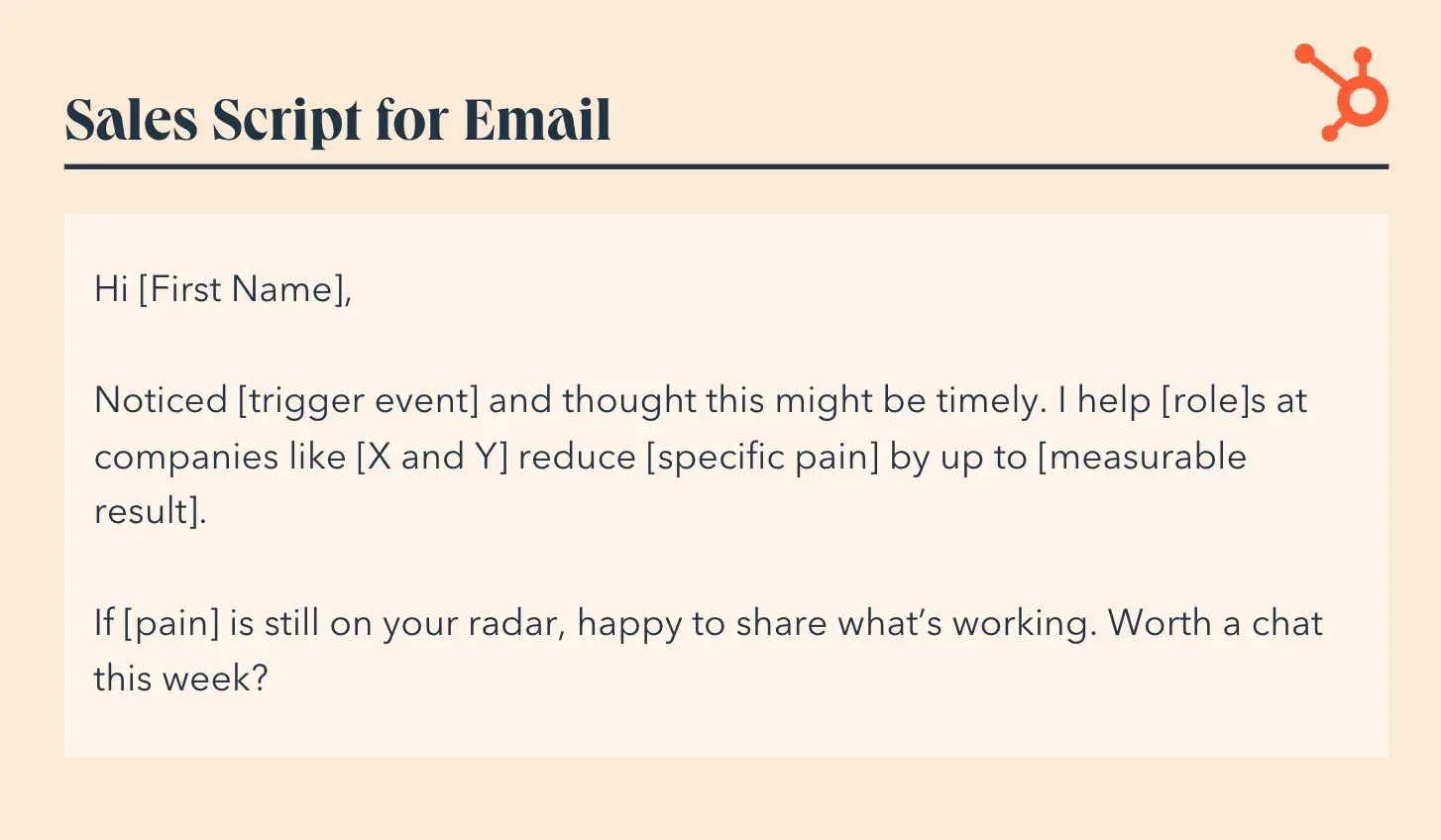
I’ve written cold emails that got 42% reply rates. I’ve also sent ones that tanked. The difference? The good ones follow what I call the 3 R’s:
- Relevance (I know who you are).
- Results (Here’s what I’ve done).
- Respect (Your time matters).
Here’s a structure I’ve used for years:
Subject: Saw this on your roadmap
Body:
Hi [First Name],
Noticed [trigger event] and thought this might be timely. I help [role]s at companies like [X and Y] reduce [specific pain] by up to [measurable result].
If [pain] is still on your radar, happy to share what’s working. Worth a chat this week?
– Diego
Short. Contextual. No fluff.
5. Sales Script for Voicemail
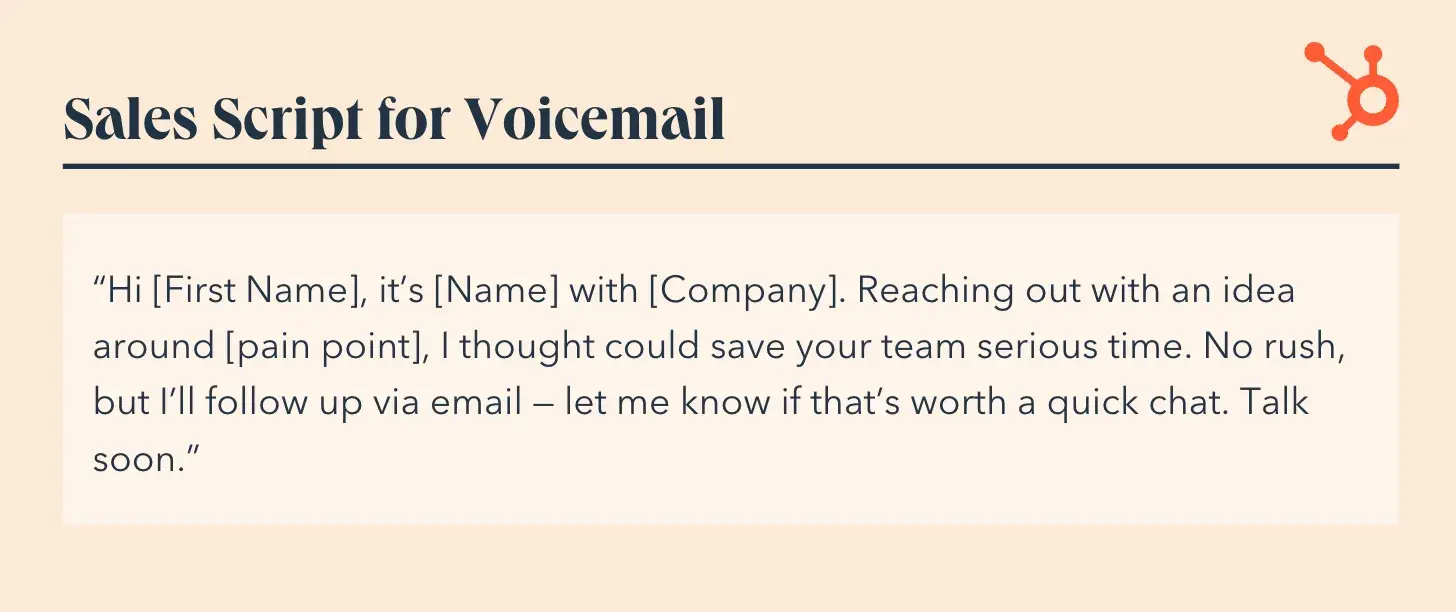
Voicemail isn’t dead. What’s dead is leaving voicemails that sound like they’re trying to sell insurance at 3x speed.
The best voicemails I leave are under 20 seconds. They spark curiosity, not conversion.
Here’s a version I’ve used successfully:
“Hi [First Name], it’s Diego with [Company]. Reaching out with an idea around [pain point], I thought could save your team serious time. No rush, but I’ll follow up via email — let me know if that’s worth a quick chat. Talk soon.”
I treat voicemail like a trailer. Not the full movie. Just enough to earn a callback — or at least get my email opened.
6. Follow-Up Email Script
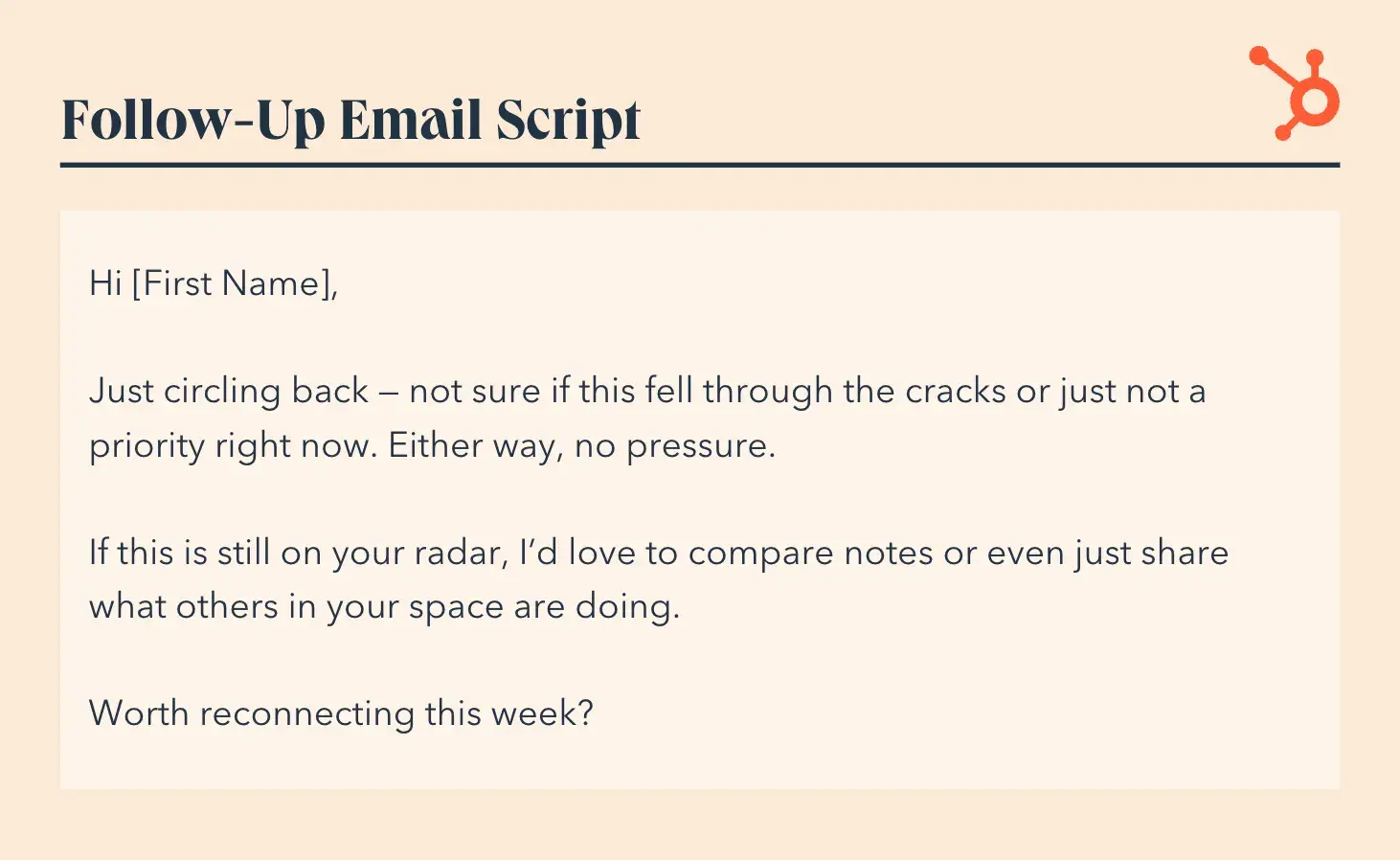
Breakup emails are like polite door-closing rituals. They let you leave with grace, but leave the handle unlocked.
I never assume silence = disinterest. Timing is the variable. And follow-up is the lever.
My best follow-up emails sound like a real human checking in, not a sales bot firing off sequence #5.
Subject: Re: [Original Email Topic]
Body:
Hi [First Name],
Just circling back — not sure if this fell through the cracks or just not a priority right now. Either way, no pressure.
If this is still on your radar, I’d love to compare notes or even just share what others in your space are doing.
Worth reconnecting this week?
Cheers,
Diego
This format has landed me 5-figure deals. Why? Because it respects the buyer’s reality. And it reopens the door without forcing a foot in.
7. Breakup Email Script
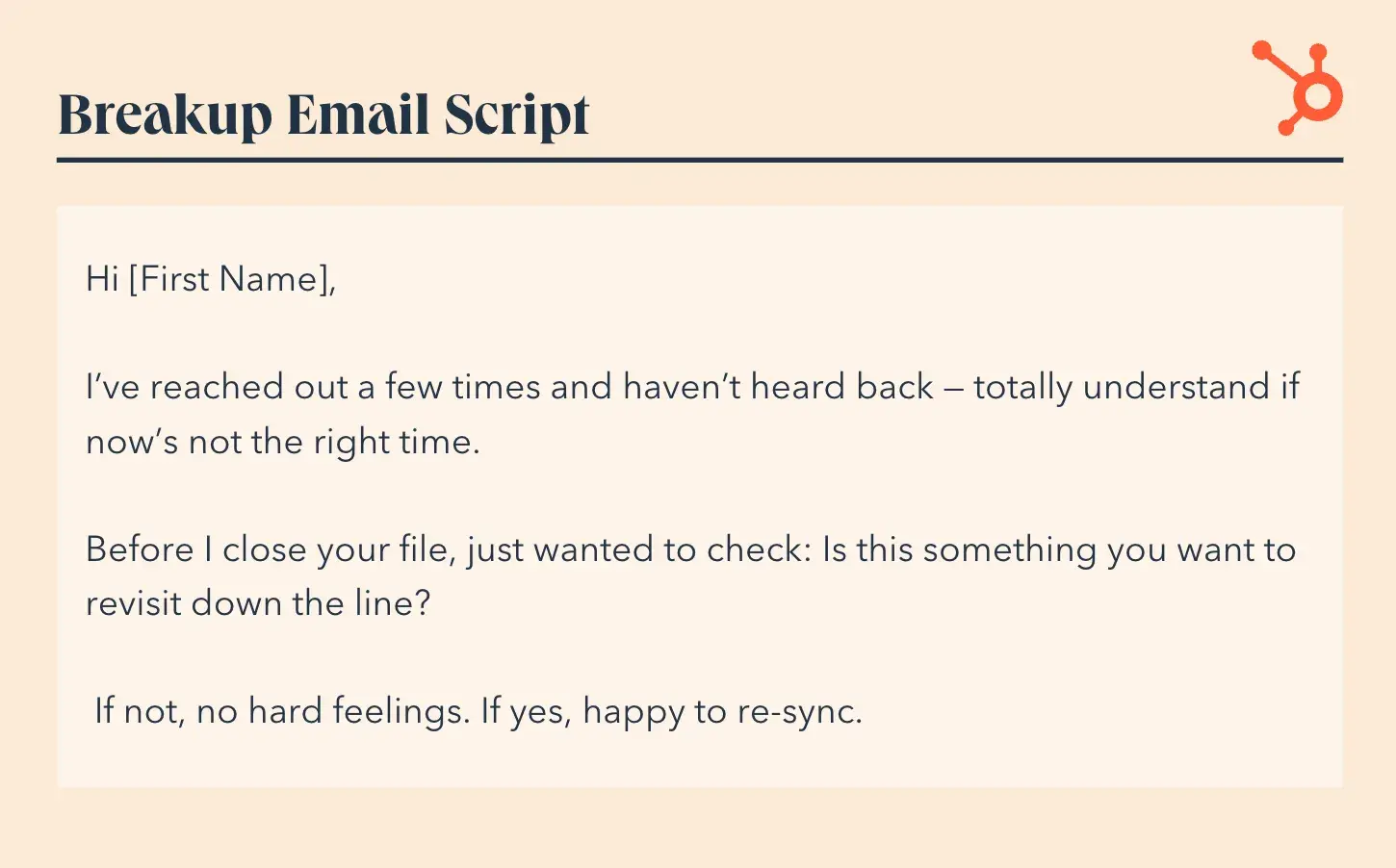
Here’s mine:
Subject: Should I close your file?
Body:
Hi [First Name],
I’ve reached out a few times and haven’t heard back — totally understand if now’s not the right time.
Before I close your file, just wanted to check: Is this something you want to revisit down the line? If not, no hard feelings. If yes, happy to re-sync.
Best,
Diego
This works more than you’d think. Not because it’s clever, but because it gives people permission to re-engage on their own terms.
8. Breakup Call Script
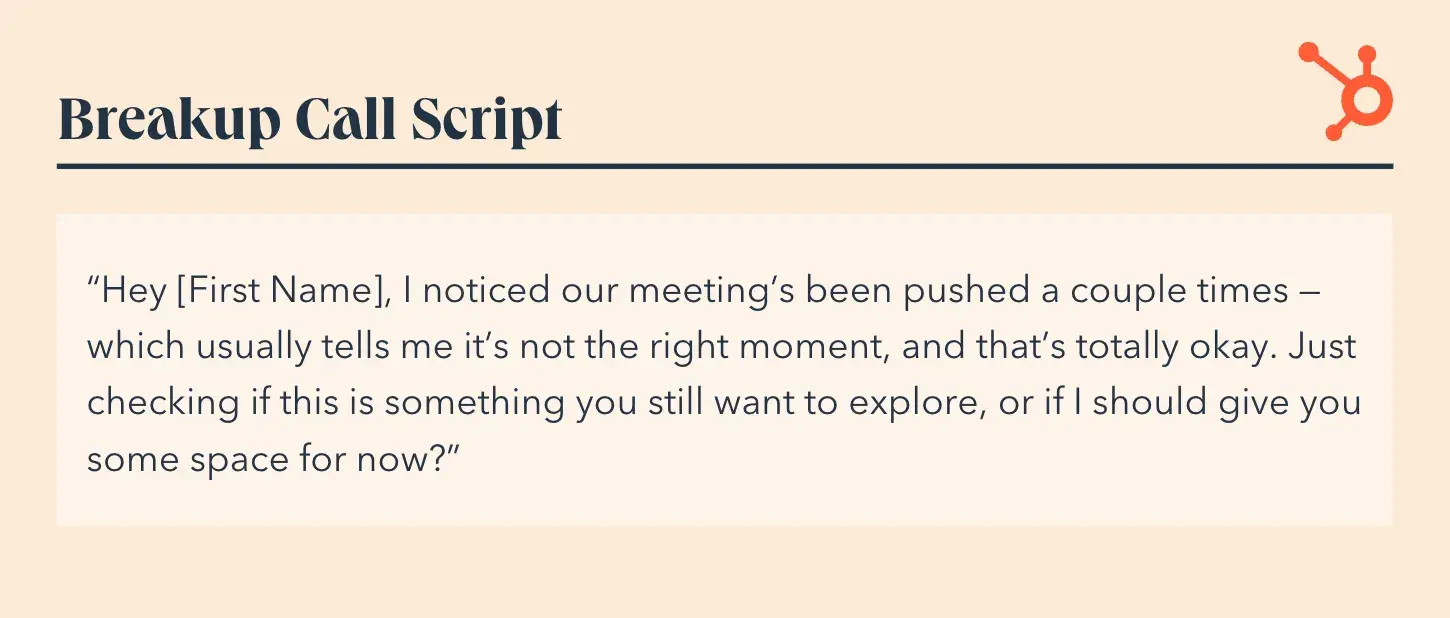
I use this when someone ghosts me after multiple touchpoints.
“Hey [First Name], I noticed our meeting’s been pushed a couple times — which usually tells me it’s not the right moment, and that’s totally okay. Just checking if this is something you still want to explore, or if I should give you some space for now?”
You’re not being dramatic. You’re being direct. It’s a reset — and it respects their time and yours.
9. Breakup Voicemail Script
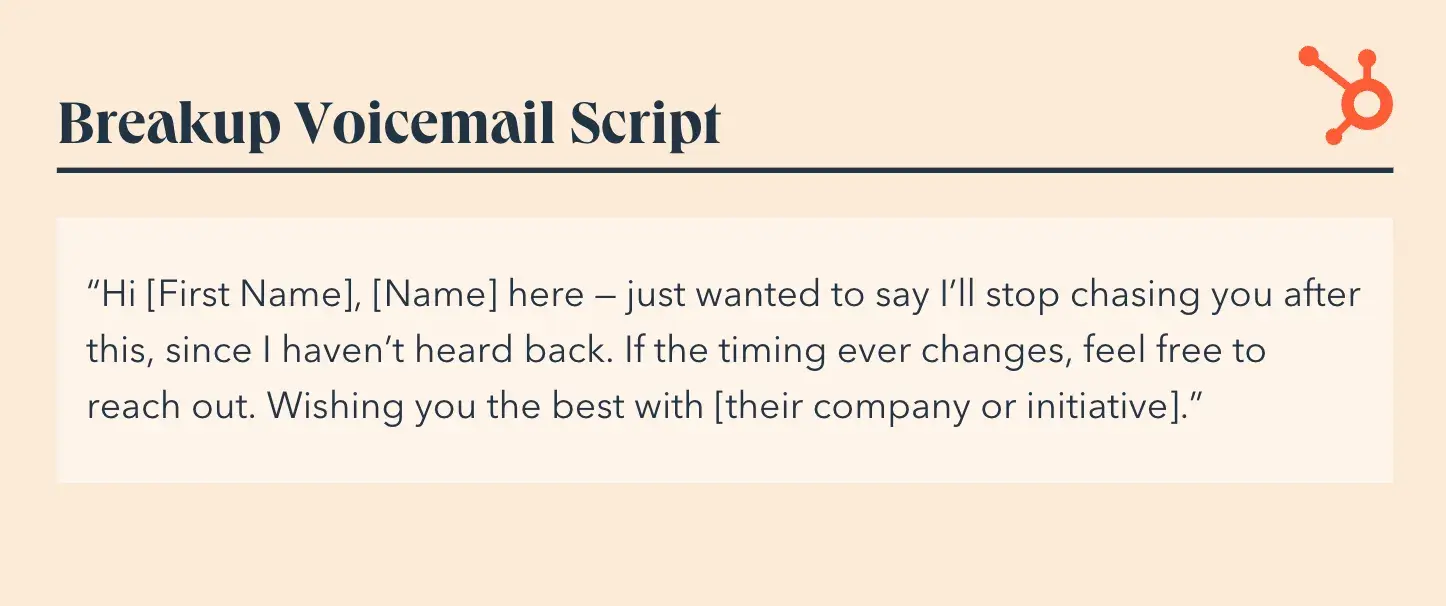
This is my closer for leads that went cold but were worth the chase.
“Hi [First Name], Diego here — just wanted to say I’ll stop chasing you after this, since I haven’t heard back. If the timing ever changes, feel free to reach out. Wishing you the best with [their company or initiative].”
You’d be surprised how often I get a reply after this. Sometimes, it’s “Let’s talk.” Other times, it’s a simple “Thanks.” Either way, I leave the call with my reputation intact and my energy focused forward.
Scripts aren’t scripts. They’re scaffolding for trust. If you build them with empathy, precision, and a real understanding of your buyer’s world, you won’t just start more conversations — you’ll start better ones.
So take these, test them, and make them yours. Because in sales, you don’t win deals by sounding perfect. You win deals by sounding like someone worth listening to.
Why use sales scripts?
I get it — the word “script” feels rigid or like something that belongs in a theater, not sales. I used to think that too. When I was starting out, I prided myself on being spontaneous, thinking on my feet, reading the room. I thought scripts would turn me into a robot, stripping away my personality and connection.
But I was wrong. And I only realized that after I lost deals I should’ve closed. After I fumbled through conversations, I could’ve led with confidence. After I watched great prospects go cold because I didn’t know how to navigate objections, frame value, or create enough tension to keep them curious.
Eventually, I stopped winging it. I started treating sales like a craft. And that’s when everything changed. I learned that a great script doesn’t restrict you — it frees you.
Here’s why I rely on them daily — and why I coach teams, founders, and SDRs to do the same.
1. Scripts build confidence and consistency, especially in high-stakes moments.
I’ve sat in hundreds of calls with talented reps who freeze the moment the energy shifts. Maybe it’s a gatekeeper throwing shade. Maybe it’s a CMO challenging their assumptions. Maybe it’s just the nerves of pitching a five-figure solution to someone who holds the P&L. I’ve been there too.
But here’s the difference: When I’ve rehearsed my script — not memorized it, but internalized it — I don’t freeze. I adjust, pivot, and stay present. Because I already know the framework, I’m not grasping for what to say next.
Salesforce found that top performers are 1.6x more likely to prep with scripts and mental models before meetings. And it makes sense. In moments of pressure, your preparation becomes your safety net. I’ve used scripts to stay grounded through C-level pushback, pricing concerns, and unexpected curveballs — and it’s saved more deals than I can count.
2. Scripts shorten the sales cycle by eliminating guesswork.
Every time I’ve launched a new outbound campaign — whether for a new vertical, a beta product, or a strategic pivot — I start with one thing: a script. Because guessing what to say costs time. And time kills deals.
I’ve seen it firsthand: once the script is tight, discovery flows. Objections are anticipated. Calls get clearer, faster. Prospects feel seen. And we stop wasting each other’s time.
The RAIN Group reports that buyers are nearly 3x more likely to purchase from reps who show a strong understanding of their challenges early. That’s the power of a well-written script — it structures understanding. It removes fluff. It keeps you focused on outcomes, not features.
For me, a script is like a GPS. I still have to drive, but I’m not getting lost.
3. They help new reps ramp faster and avoid costly mistakes.
I’ve onboarded reps in startups, coached founders doing cold outreach for the first time, and built playbooks for teams scaling across regions. And every time, I come back to the same tool: the script vault.
It’s not just a cheat sheet. It’s a system for transferring what works. When a new SDR uses a tested script, they’re not starting from zero — they’re starting with leverage.
I’ve seen new hires book meetings in week one with the right script. I’ve also seen reps spin their wheels for months without one, stuck rewriting the same awkward opener, or fumbling through objections they should’ve seen coming.
McKinsey reports that companies with standardized sales messaging outperform competitors by up to 20% in revenue growth. That’s not about being boring — that’s about scaling what works. A good script creates repeatable wins. And that’s what turns junior reps into closers.
4. Scripts are the fastest way to identify what works (and what doesn’t).
I treat my scripts like live hypotheses. Every line is a test. Every pause is data. If I swap out an opener and response rates go up, I keep it. If they drop? I tweak again.
Over the years, I’ve built dozens of micro-variations across industries: from fintech to SaaS, healthcare to AI. I’ve tracked how founders respond to urgency versus logic. How VPs react to social proof versus ROI framing. I’m not guessing. I’m iterating — and that’s what separates reactive reps from high performers.
Because here’s the truth: If you don’t use a script, you can’t improve it. You’re just relying on gut feel. And gut doesn’t scale.
5. A script turns “talk tracks” into strategic conversations.
Here’s my unpopular opinion: Most reps talk too much. They confuse features with value, overexplain, and pitch instead of diagnose. It’s not because they don’t care — it’s because they don’t have a structure to guide them.
When I write a new script, I force myself to include five open-ended questions for every one value prop. That’s not arbitrary — that’s strategic. It keeps the focus where it should be: on the buyer’s goals.
HubSpot data shows that high-converting calls maintain a near 43:57 talk-to-listen ratio. That means the best reps talk less than half the time. A strong script makes that possible — even when you’re nervous, or when the conversation veers off-track.
I use scripts to ask better questions, not give longer answers.
Final Thought: Use the script as a compass, not a cage.
The biggest shift in my sales career came when I stopped seeing scripts as something I had to hide and started using them as a strength. Not a script to follow blindly, but a structure to show up smarter, faster, and more human.
The best reps I’ve worked with all had one thing in common: They didn’t sound scripted. But every move they made was intentional. They had rehearsed. They had frameworks. They had fallback plans. And that’s what made them sound natural, not lucky.
I coach sellers today the same way I coach myself: Don’t memorize the script. Instead, learn the rhythm, understand the psychology, and get so comfortable with it that you can throw it away when you need to — and still land the point.
Because in the end, a script isn’t there to make you sound polished. It’s there to make you present.
And presence is what closes deals.
Scripts free you to sell better.
In my career, I’ve built dozens of script variations — from cold openers to complex objection-handling sequences. And here’s what I’ve learned: The best sales scripts don’t make you sound robotic — they make you sound prepared. They create consistency without killing creativity, and they help you deliver relevance, not repetition.
Some reps still argue that scripts feel unnatural. I’d counter that what feels “natural” is usually just familiar. Once you’ve internalized a script that’s truly designed around your buyer’s problems, priorities, and language, it becomes your natural rhythm.
And that’s the real secret: A script can free you up to listen better, ask smarter, and move faster.
If you treat a script like a teleprompter, you’ll lose the room. But if you treat it like a framework — like a compass — you’ll earn trust, time, and eventually, the close.
So build scripts that sound like you. Refine them with data. Practice them like a craft. And then, when it’s showtime, show up human. Because the real power of a sales script isn’t in the words themselves — it’s in what they allow you to become when it matters most.
Editor’s note: This post was originally published in December 2017 and has been updated for comprehensiveness.
![]()






![Free Resource: 30 Sales Call Script Templates [Download Now]](https://no-cache.hubspot.com/cta/default/53/64e5789a-605c-4e14-90d9-8aa3df310ee1.png)
